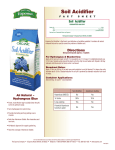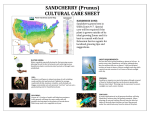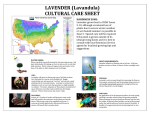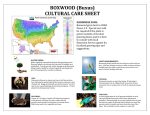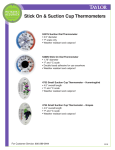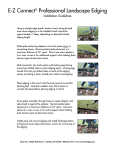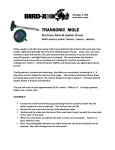Transcript
HYDRANGEA (Hydrangea) CULTURAL CARE SHEET HARDINESS ZONE: Hydrangeas grow best in USDA Zones 4-‐9. Special care will be required if the plant is grown outside of its ideal growing Zones and it is best to consult with local Extension Service agents for localized growing tips and suggestions. LIGHT REQUIREMENTS: Water regularly, never allowing the soil to completely dry out. Hydrangea plants will not tolerate drought conditions. During period of excessive dryness, supplementary watering will be needed. Hydrangeas prefer partial sun but will tolerate full sun in cooler climates, as long as adequate root moisture is available. In hot climates, partial shade with cool, moist soil is the best location. A full sun location receives at least six hours of direct sunlight each day while a partial sun site receives 4 to 6 hours of direct sunlight each day. Partial shade receives a maximum of 4 hours of direct sunlight each day. Dappled shade usually qualiJies as a partial shade location. SOIL: Hydrangeas are adaptable to almost any type of soil but perform best if planted in organically rich, moisture retentive, well-‐drained soil. Boggy, consistently wet soils promote “wet feet” and are not a good planting site for Hydrangea plants. On the Jlip side, dry and sandy soils do not normally retain the necessary moisture levels for Hydrangea to thrive without artiJicial watering methods. Protect plants from drying winter winds. PRUNING: It is important to know the whether the Hydrangea blooms on old growth or on new growth before trimming the plant. If it blooms on old growth, prune to shape directly after Jlowering in summer. If it blooms on new growth, prune to 6-‐8 inches tall anytime from Jirst hard frost of fall until new growth begins in spring. WATER NEEDS: MULCHING: A layer of 2-‐3 inches of mulch will help keep moisture in the ground, will keep the roots cooler, and will provide vital nutrients to the plant as it breaks down. Mulch may need to be reapplied each year. FERTILIZE: A yearly application of an all-‐purpose fertilizer will help Hydrangeas achieve their full growth potential. Flower color may or may not be affected by the soil pH levels, although many Hydrangea varieties will bloom pink in neutral soils and bloom blue in acidic soils. Treat soil with aluminum sulfate to get blue Jlowers or add lime for pink blooms. When planting, do not put fertilizer directly into the hole but rather, if desired, place fertilizer on top of the ground under the mulch and away from the stem of the plant.
